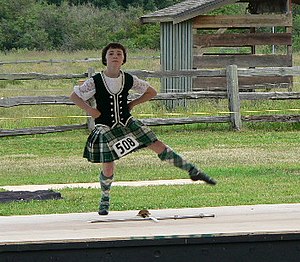Highland dancing
Highland dancing is the national dance of Scotland. It is an integral part of nearly every Highland games event where, in its most common public face, the dancers can be seen competing in traditional dances wearing colorful Highland attire and accompanied by bagpipe music. It is in the context of these competitions that Highland dancing evolved over the years into its present form.
However, neither competition, nor Highland attire, nor bagpipe music is a necessary part of Highland dancing. Sometimes the dance form can be seen in exhibitions (or danced for pleasure) with the dancers wearing uniquely designed costumes and dancing a choreographed routine to theme music of their choosing.
Judging
Judges evaluate a dancer on three major criteria: timing, technique, and artistic interpretation (deportment).
Timing concerns the ability of the dancer to follow the rhythm of the music.
Technique has to do with the correct execution of the steps in coordination with the movements of the rest of the body, including head, arm and hand movements.
Artistic interpretation covers that essential element of all dance and artistry in general which cannot be quantified or reduced to any set of rules or specific points, but which does concern the ability of the dancer or performer to convey a sense of feeling, understanding, and appreciation of the art form.
The various governing bodies of highland dancing establish parameters for the dances themselves and scoring systems to grade the dancers and determine their class and progress from one class to another.
